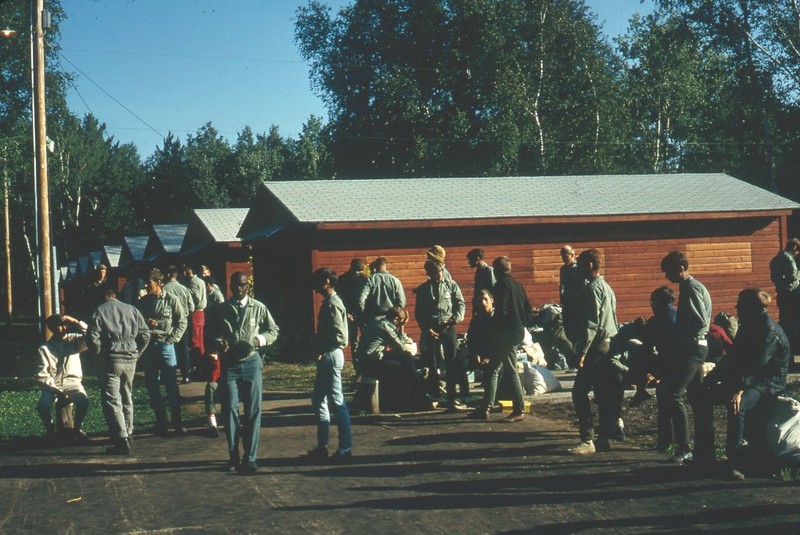Statehouse Youth Conservation Corps Camp
Introduction
Text-to-speech Audio
The 1960s was a decade of the Environmental Movement, and Gaylord Nelson was a champion of environmental activism in Wisconsin as well as the nation. He was the founder of Earth Day. The Wisconsin Youth Conservation Corps was created through his inspiration and guidance as governor of Wisconsin from 1959-1963 and U.S senator from our state from 1963-1981. The YCC was modeled after the Civilian Conservation Corps legacy. The first Youth Conservation Corps camp in Wisconsin and the nation was created in Manitowish Waters, Wisconsin at Statehouse Lake in 1962. High school students aged 16-18 recommended by their principals were invited to apply for summer camp.
Written by Kay Krans
Images

.jpg)




.jpg)
Backstory and Context
Text-to-speech Audio
In 1961, Governor Gaylord Nelson worked to create legislation named the Outdoor Recreation Action Program that allowed Wisconsin to acquire over one million acres of land for recreation and preservation, and created the Wisconsin Youth Conservation Corps. In addition to the $50 million to acquire land, the YCC was first funded by a one cent cigarette tax. The program put high school age men, and later women, to work on projects that were designed by the Wisconsin DNR. The goal was to find young men and women interested in conservation and in possibly pursuing careers in environmental education and areas that involved the natural resources of our country. “Within nine months, 200 youth had enrolled. Two-thirds of the nearly 80,000-worker-days expended in the first five years of the program went into timber stand improvement such as clearing, planting, thinning and release projects along with parks development.” The early campers made $18 a week plus room and board. The Wisconsin YCC worked on projects designed by the Wisconsin Conservation Department (today the WDNR). The projects were created from five field divisions: Parks and Recreation, Forest Management, Forest Protection, Game Management, and Fisheries Management. Campers were supervised by professionals from the Trout Lake, Mercer, and Woodruff offices of the DNR and their YCC camp counselors. Projects were designed so campers could see finished projects before their session was completed, building pride and ownership in the finished work. Statehouse Lake and the Wisconsin YCC program became the model used in creating the federal YCC program, which was signed into law by President Richard Nixon in 1970. This was a true testament to the success of the Wisconsin YCC program. By 1974, the U.S. Congress expanded the federal program and made it a permanent national program on September 3, 1974.
Alumni of Statehouse still visit the North Lakeland Discovery Center and talk about the campsites they created, trails they cleared through the woods, fish cribs, and fire lanes they created that the public still benefits from today. Things changed at camp over the years, but the work continued, completing projects for the Department of Natural Resources. The boys had longer hair, and there were now girls who had the opportunity to work in the field and determine if this would be their lifelong work. More effort was made in including minority youth from the inner city of Milwaukee. Discipline changed with the times and the mood of the country. In 1995, the YCC camps closed its doors. One camper stated, “We had hands-on educational times in the woods with our leaders learning about plants, animals, and eco systems. We took field trips, lived in cabins, and had simple meals. We were paid a modest sum for our efforts, and it was totally worth it.” More than 24,000 Wisconsin high school students participated at work camps across the state. By the mid-1990s, budget cuts, liability concerns, and changing social norms created issues for the Corps. In 1995, sadly, the program was discontinued because of lack of funds in the state budget. An article in the Natural Resources magazine on the 30th anniversary of the YCC had this statement by the director of the Youth Conservation Corps for the Department of Natural Resources. "The simple truth of the matter," said DNR's last YCC Chief, Ray Hendrikse, "is that without the assistance of the youth camps, development, restoration and maintenance of state parks, wildlife areas, forests, streams and lakes would be severely reduced. Without them, conservation work would continue to get done, but to a much lesser degree..."
In 1996, an ad appeared in the local newspaper advertising the availability of Statehouse Camp for lease by the Wisconsin Department of Natural Resources. Because of the vision of teachers and citizens in the Manitowish Waters area, the camp was leased and went on to become the North Lakeland Discovery Center. The NLDC is a place to continue learning about the wise use of our natural resources and to foster a land ethic for future generations of our state and nation.
For more history, take a tour of the center and find the YCC signs that share many more details about the YCC Camp, the youth, the projects, and how some followed careers in the natural resources.
Sources
Bibliography
Nelson, Gaylord Papers, Wisconsin YCC, Wisconsin Historical Society Archives, Madison, Wisconsin
State Youth Conservation Camps Work Projects Report, Wisconsin Conservation Department, Madison, Wisconsin. 1966
Mueller, Gary. 25 years of YCC: the legacy continues. Wisconsin Natural Resources Vol. 10, No.2. March-April 1986
Driestein, Rob. YCC at 30. Wisconsin Natural Resources Vol. 16, No. 4. August 1992.
Mayfield, Bob Statehouse Lake YCC 1970-1975. Telephone interview. August 26, 2019.
Sande, Thor. Reflections on his time at Statehouse Lake. Telephone interview. 2019.
